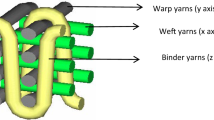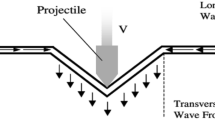The lightweight ceramic/aluminum alloy composite armor design is examined and optimized to get better protective performance. The armor penetrability is simulated via the smooth particle hydromechanics approach using the ANSYS/AUTODYN software. The accuracy of the program was verified by comparing with known data. Three composite armor types with the total thickness of 30, 40, and 50 mm, and five different ceramic/metal thickness ratios were analyzed in simulation of the residual bullet speed and the final distance. Simulation results are compared with the theoretical model. The best bullet protective performance of the three armor types was obtained with the ceramic/aluminum alloy thickness ratio of 4:1.




Similar content being viewed by others
References
H.-L. Hou, X. Zhu, Z.-J. Liu, et al., “Experimental study on performance of ceramic composite warship armor under impact of high speed fragment,” Ordnance Mater. Sci. Eng., No. 3, 5–10 (2007).
L. B. Lucy, “A numerical approach to the testing of the fission hypothesis,” Astron. J., 82, 1013–1024 (1977).
R. A. Gingold and J. J. Monaghan, “Smoothed particle hydrodynamics – Theory and application to non-spherical stars,” Mon. Not. R. Astron. Soc., 181, 375–389 (1977).
V. Sánchez Gálvez and L. Sánchez Paradela, “Analysis of failure of add-on armor for vehicle protection against ballistic impact,” Eng. Fail. Anal., 16, No. 6, 1837–1845 (2009).
A. L. Florence and T. J. Ahrens, Interaction of Projectiles and Composite Armor, Final Report, Stanford Research Institute, Menlo Park, CA (1967).
B. Wang and G. Lu, “On the optimisation of two-component plates against ballistic impact,” J. Mater. Process. Tech., 57, Nos. 1–2, 141–145 (1996).
D. Grady, “Impact failure and fragmentation properties of tungsten carbide,” Int. J. Impact Eng., 23, No. 1, 307–317 (1999).
D. J. Steinberg, S. G. Cochran, and M. W. Guinan, “A constitutive model for metals applicable at high-strain rate,” J. Appl. Phys., 51, No. 3, 1498–1504 (1980).
T. J. Holmquist, D. W. Templeton, and K. D. Bishnoi, “Constitutive modeling of aluminum nitride for large strain, high-strain rate, and high-pressure applications,” Int. J. Impact Eng., 25, No. 3, 211–231 (2001).
G. R. Johnson and W. H. Cook, “Fracture characteristics of three metals subjected to various strains, strain rates, temperatures and pressures,” Eng. Fract. Mech., 21, No. 1, 31–48 (1985).
Acknowledgments
This work was supported by the National Natural Science Foundation of China (Nos. 11602068 and 11602066) and Fundamental Research Funds for the Central Universities (Nos. HEUCFM170203, HEUCFP201744, and HEUCFP201762).
Author information
Authors and Affiliations
Corresponding author
Additional information
Translated from Problemy Prochnosti, No. 1, pp. 16 – 23, January – February, 2019.
Rights and permissions
About this article
Cite this article
Chang, ZL., Zhao, WL., Zou, GP. et al. Simulation of the Lightweight Ceramic/Aluminum Alloy Composite Armor for Optimizing Component Thickness Ratios. Strength Mater 51, 11–17 (2019). https://doi.org/10.1007/s11223-019-00044-1
Received:
Published:
Issue Date:
DOI: https://doi.org/10.1007/s11223-019-00044-1




